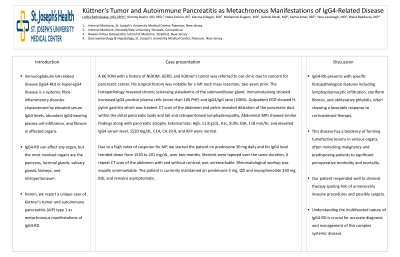Tuesday Poster Session
Category: Biliary/Pancreas
P3591 - Küttner’s Tumor and Autoimmune Pancreatitis as Metachronous Manifestations of IgG4-Related Disease
Tuesday, October 29, 2024
10:30 AM - 4:00 PM ET
Location: Exhibit Hall E

Has Audio

Lefika Bathobakae, MD
St. Joseph's University Medical Center
Paterson, NJ
Presenting Author(s)
Lefika Bathobakae, MD1, Rammy Bashir, MD2, Heba Farhan, BS3, Katrina Villegas, MD4, Gabriel Melki, MD5, Kamal Amer, MD5, Yana Cavanagh, MD5
1St. Joseph's University Medical Center, Paterson, NJ; 2St. George’s University School of Medicine, Grenada, West Indies, Paterson, NJ; 3Rowan-Virtua University School of Osteopathic Medicine, Paterson, NJ; 4St. Joseph’s University Medical Center, Paterson, NJ; 5St. Joseph's University Medical Center, Paterson, NJ
Introduction: Immunoglobulin G4-related disease (IgG4-RD) or hyper-IgG4 disease is a systemic fibro-inflammatory disorder characterized by elevated serum IgG4 levels, abundant IgG4-bearing plasma cell infiltration, and fibrosis in affected organs. IgG4-RD can affect any organ, but the most involved organs are the pancreas, lacrimal glands, salivary glands, kidneys, and retroperitoneum. Herein, we report a unique case of Küttner’s tumor and autoimmune pancreatitis (AIP) type 1 as metachronous manifestations of IgG4-RD.
Case Description/Methods: A 66-year-old male with a history of NIDDM, GERD, and Kütner’s tumor was referred to our clinic due to concern for pancreatic cancer. His surgical history was notable for a left neck mass resection two years prior. The histopathology revealed chronic sclerosing sialadenitis of the submandibular gland. Immunostaining showed increased IgG4 positive plasma cells (more than 100 PHF) and IgG4/IgG ratio (100%). Outpatient EGD showed H.pylori gastritis, which was treated. CT scan of the abdomen and pelvis revealed dilatation of the pancreatic duct within the distal pancreatic body and tail and retroperitoneal lymphadenopathy. Abdominal MRI showed similar findings along with pancreatic atrophy. External labs: Hgb, 11.8 g/dL, A1c, 8.0%, ESR, 118 mm/hr, and elevated IgG4 serum level, 1520 mg/dL. CEA, CA 19-9, and AFP were normal.
Due to a high index of suspicion for AIP, we started the patient on prednisone 30 mg daily, and his IgG4 level trended down from 1520 to 201 mg/dL over two months. Steroids were tapered over the same duration. A repeat CT scan of the abdomen with and without contrast was unremarkable. Rheumatological workup was equally unremarkable. The patient is currently on prednisone 5 mg, QD, and mycophenolate 250 mg, BID, and remains asymptomatic.
Discussion: IgG4-RD presents with specific histopathological features, including lymphoplasmacytic infiltration, storiform fibrosis, and obliterative phlebitis, often showing a favorable response to corticosteroid therapy. This disease tends to form tumefactive lesions in various organs, often mimicking malignancy and predisposing patients to significant perioperative morbidity and mortality. Our patient responded well to steroid therapy, sparing him from unnecessary invasive procedures and possibly surgery. Understanding the multifaceted nature of IgG4-RD is crucial for accurately diagnosing and managing this complex systemic disease.
Disclosures:
Lefika Bathobakae, MD1, Rammy Bashir, MD2, Heba Farhan, BS3, Katrina Villegas, MD4, Gabriel Melki, MD5, Kamal Amer, MD5, Yana Cavanagh, MD5. P3591 - Küttner’s Tumor and Autoimmune Pancreatitis as Metachronous Manifestations of IgG4-Related Disease, ACG 2024 Annual Scientific Meeting Abstracts. Philadelphia, PA: American College of Gastroenterology.
1St. Joseph's University Medical Center, Paterson, NJ; 2St. George’s University School of Medicine, Grenada, West Indies, Paterson, NJ; 3Rowan-Virtua University School of Osteopathic Medicine, Paterson, NJ; 4St. Joseph’s University Medical Center, Paterson, NJ; 5St. Joseph's University Medical Center, Paterson, NJ
Introduction: Immunoglobulin G4-related disease (IgG4-RD) or hyper-IgG4 disease is a systemic fibro-inflammatory disorder characterized by elevated serum IgG4 levels, abundant IgG4-bearing plasma cell infiltration, and fibrosis in affected organs. IgG4-RD can affect any organ, but the most involved organs are the pancreas, lacrimal glands, salivary glands, kidneys, and retroperitoneum. Herein, we report a unique case of Küttner’s tumor and autoimmune pancreatitis (AIP) type 1 as metachronous manifestations of IgG4-RD.
Case Description/Methods: A 66-year-old male with a history of NIDDM, GERD, and Kütner’s tumor was referred to our clinic due to concern for pancreatic cancer. His surgical history was notable for a left neck mass resection two years prior. The histopathology revealed chronic sclerosing sialadenitis of the submandibular gland. Immunostaining showed increased IgG4 positive plasma cells (more than 100 PHF) and IgG4/IgG ratio (100%). Outpatient EGD showed H.pylori gastritis, which was treated. CT scan of the abdomen and pelvis revealed dilatation of the pancreatic duct within the distal pancreatic body and tail and retroperitoneal lymphadenopathy. Abdominal MRI showed similar findings along with pancreatic atrophy. External labs: Hgb, 11.8 g/dL, A1c, 8.0%, ESR, 118 mm/hr, and elevated IgG4 serum level, 1520 mg/dL. CEA, CA 19-9, and AFP were normal.
Due to a high index of suspicion for AIP, we started the patient on prednisone 30 mg daily, and his IgG4 level trended down from 1520 to 201 mg/dL over two months. Steroids were tapered over the same duration. A repeat CT scan of the abdomen with and without contrast was unremarkable. Rheumatological workup was equally unremarkable. The patient is currently on prednisone 5 mg, QD, and mycophenolate 250 mg, BID, and remains asymptomatic.
Discussion: IgG4-RD presents with specific histopathological features, including lymphoplasmacytic infiltration, storiform fibrosis, and obliterative phlebitis, often showing a favorable response to corticosteroid therapy. This disease tends to form tumefactive lesions in various organs, often mimicking malignancy and predisposing patients to significant perioperative morbidity and mortality. Our patient responded well to steroid therapy, sparing him from unnecessary invasive procedures and possibly surgery. Understanding the multifaceted nature of IgG4-RD is crucial for accurately diagnosing and managing this complex systemic disease.
Disclosures:
Lefika Bathobakae indicated no relevant financial relationships.
Rammy Bashir indicated no relevant financial relationships.
Heba Farhan indicated no relevant financial relationships.
Katrina Villegas indicated no relevant financial relationships.
Gabriel Melki indicated no relevant financial relationships.
Kamal Amer indicated no relevant financial relationships.
Yana Cavanagh indicated no relevant financial relationships.
Lefika Bathobakae, MD1, Rammy Bashir, MD2, Heba Farhan, BS3, Katrina Villegas, MD4, Gabriel Melki, MD5, Kamal Amer, MD5, Yana Cavanagh, MD5. P3591 - Küttner’s Tumor and Autoimmune Pancreatitis as Metachronous Manifestations of IgG4-Related Disease, ACG 2024 Annual Scientific Meeting Abstracts. Philadelphia, PA: American College of Gastroenterology.
